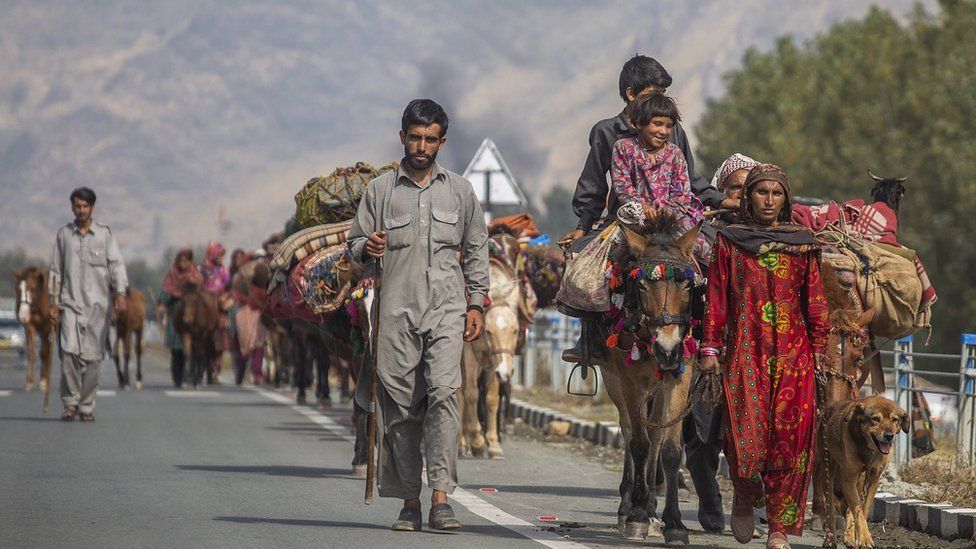ARTICLE AD BOX
 Image source, ABID BHAT
Image source, ABID BHAT
The Bakarwals are part of a 3.4-million-strong nomad community in Jammu and Kashmir
In Indian-administered Kashmir, a nomadic tribe is struggling to maintain its traditional lifestyle in the face of changing forest landscapes and weather conditions.
"People try to paint a rosy picture of our life but ours is, in fact, a saga of endurance and miseries," says Liaqat Khan, a shepherd from the Bakarwal tribe.
The Bakarwals are part of a 3.4 million-strong nomadic community of the Jammu and Kashmir region, whose primary occupation is rearing cattle.
At around 55km (34.17 miles) from Srinagar - the summer capital of Jammu and Kashmir - they camp in Dardwodur forests.
Image source, ABID BHAT
Image caption,The Bakarwals are nomadic forest dwellers
In these alpine woods, they carry out their traditional routine - women collect firewood for the stoves of their makeshift kitchen, kids play and giggle around their goats, while men go uphill to graze their herd.
The community has for centuries relied on the forest and lived off this land to survive and thrive.
Image source, ABID BHAT
Image caption,They rear cattle and live on forest lands
They spend six months in Kashmir during summers, arriving in the valley in April. By October, they return to the plains of Jammu for the winters.
"We belong to nowhere," says Zulfi, a young Bakarwal girl in Kashmir. "This is just our summer home and we will stay here for the time being before moving to Jammu for the six-month-long stay there."
Image source, ABID BHAT
Image caption,In the winters, the community heads to the warmer plains of Jammu for six months
The Bakarwals were officially declared as a "scheduled tribe" - tribal communities recognised by the India's Constitution as socially and economically disadvantaged - by the federal government in 2001.
Today, the tribe fears for the endurance of its traditional lifestyle due to increased wild animal attacks on their cattle - their main source of income.
Image source, ABID BHAT
Image caption,Tribe members say they have no permanent home
The community also struggles with increased instances of inclement weather. "It's extremely difficult to travel to the high altitude pastures of the Himalayas," says Liaqat Khan, a shepherd.
In June, unseasonal snowfall and severe cold weather conditions in Chenab valley of Jammu and Kashmir left hundreds of tribal families stuck on road sides, with little food or fodder.
Image source, ABID BHAT
Image caption,They live on the roadside or in makeshift huts or tents when they travel
Another major concern for the tribe is their access to forest lands.
Last year, hundreds of families from the community were served eviction notices for "illegally" occupying forests which they have lived in for decades. Authorities also demolished several houses - the community lives in temporary tents mud huts in these areas.
A few months later, however, Lieutenant Governor Manoj Sinha said authorities would work to safeguard the rights of tribal communities in the region and provide them with rights certificates.
Image source, ABID BHAT
Image caption,Increased wild animal attacks and instances of inclement weather threaten their traditional lifestyle
The harsh realities of their current existence are pushing the tribe's younger generation to focus on getting a good education and living an easier life.
The administration has also set up community schools to educate children of such tribes in forest areas.
Image source, ABID BHAT
Image caption,Access to forest lands is a major concern for the tribe
Despite various kinds of pressures on the community, many say they are determined to stick to their traditional lifestyle.
"We aren't giving up on anything," says Zulfi. "Although we are uncertain about our lives, we are firmly holding on to our traditions, no matter what."
All images by Abid Bhat. Text by Zaid Bin Shabir

 2 years ago
22
2 years ago
22








 English (US)
English (US)